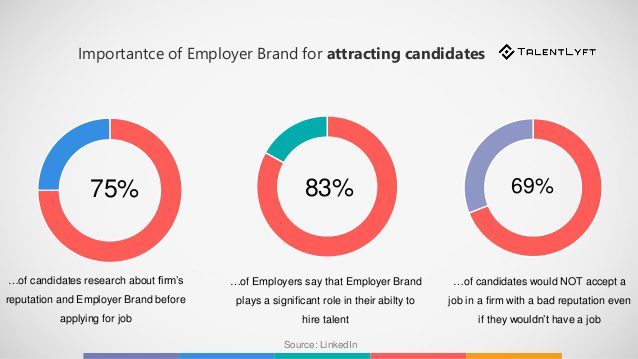Employee Engagement: A Critical Part of Your Employer Branding Strategy

Employee engagement is the cornerstone of your employer branding strategy. If your employees are not happy and engaged, presenting your company as the employer of choice and a great place to work will be impossible. In the time of social media and company review sites such as Glassdoor, employee engagement has become the critical part of every successful employer branding strategy.
What is employee engagement?
Employee engagement is the term used for employees’ emotional connection, involvement and enthusiasm about their job and organization. Engaged employees are those who strive to do their job in the best possible way and are ready to go the extra mile. They are motivated and productive and invested in achieving their company’s goals.
There are many reasons why employee engagement is important. If your employees are engaged, they will be more productive and they will work hard to help your company achieve better business results. According to Gallup, organizations with high employee engagement outperform those with low employee engagement by 147% in earnings per share.
Unfortunately, according to Gallup’s latest State of the Global Workplace report, 85% of employees are not engaged or are actively disengaged at work. The economic consequences of this global “norm” are approximately $7 trillion in lost productivity!
What is employer branding?
Employer branding is the process of creating and continually promoting your employer brand. Employer brand is your company’s reputation as the employer.
A strong employer brand communicates that your company is a good employer and a great place to work. Presenting your company as the desirable place to work will help you attract the attention of the top talent and convincing them to apply to your open job positions.
According to the LinkedIn survey, 75% of candidates do a research research on company’s reputation before they apply for a job. If your company has a bad reputation as an employer, a shocking 69% of candidates won’t apply – even if they are unemployed!

Besides for attracting the top talent, employer brand is also important for keeping them. According to CR Magazine, 92% of people would consider changing jobs if offered a role with a company with an excellent employer brand.
The link between employee engagement and employer branding
Employee engagement is the cornerstone of your employer branding strategy. If your employees are not happy and engaged, presenting your company as the employer of choice and a great place to work will be impossible.
What your employees are saying about your company has the greatest influence on your employer brand. According to Edelman Trust Barometer, employee voice is 3 times more credible than the CEO’s when it comes to talking about working condition in that company.
This is especially important in the modern digital time of social media and company review sites such as Glassdoor. Company review sites can make or break your employer brand. According to Glassdoor survey, more than a half of online job seekers read online reviews before deciding to apply for a job!
In times like this, employee engagement has become the critical part of every successful employer branding strategy.
How to use employee engagement in your employer branding strategy?
People trust people more than they trust brands. This is why you need to put a spotlight on your employees – not on your company! If your employees and happy and engaged, they are your best bet for creating a strong employer brand.
So how can you turn your employees into your employer brand ambassadors? Give your employees a voice and let them tell their story. Here are the top 4 ways you can utilize employee engagement in your employer branding strategy:
1. Feature your employees’ testimonial videos on your career site
Your career site should be at the centre of your employer branding strategy. A perfect career site should most definitely include testimonials form your employees. In today’s modern digitized time, producing short, high quality videos is not an impossible task. It is affordable, easy and – fun! Make sure your employees have a fun experience while creating this video. It will show!
2. Highlight your employees quotes and photos on your company’s social media profiles
You can take the best quotes from your employee video testimonials and highlight them on social media. Make sure to use your real employees photos – preferably headshots. As tempting as it may be, don’t reach out for stock photos. Instead, show off your real employees’ faces. Show the world (and potential candidates out there) how much you’re proud of your current employees!
3. Encourage your employees to write on your company’s career blog
Publishing a blog written by your employees is one of the best ideas for your company’s career blog. Encourage your employees to be creative, express themselves and show their personalities as well as their professional interests and experience. Let them write about anything they find important and want to address. Remember, your candidates want to read personal stories from their future colleagues they will spend most of their daily hours with!
4. Set up an employee referral program
Employee referral programs are one of the most effective methods for finding and hiring the best talent. By setting up a structured employee referral program, many companies have improved their time, cost and quality of hire. By asking your current employees to recommend great candidates from their personal networks, you will show them that you value their opinion and give them a chance to take part in your company’s hiring process. Make sure to show your appreciation by offering employee referral rewards. As a result, your employees will be more engaged and you will improve your company’s retention rates.
To ensure your employees’ buy-in all these 4 employer branding strategies, start by explaining to them that you need their help. Stress the importance of their contribution. Finally, make sure to express your gratitude and appreciation of their extra effort.
What if your employees are not engaged?
You can’t build a successful employer branding strategy if your employees are not engaged at work and enthusiastic about working at your company. Therefore, before investing in your employer brand, you should learn how to increase employee engagement.
About the Author
Kristina Martić is a Director of Marketing and Employer Branding at TalentLyft. She is an experienced digital marketer and a certified Recruitment Marketer passionate about latest marketing and recruiting trends.

